In Texas, it is possible to spot 11 different species of Hawks. These are:
- Red-Tailed Hawk
- Northern Harrier
- Broad-winged Hawk
- Harris’s Hawk
- Ferruginous Hawk
- Swainson’s Hawk
- Sharp-shinned Hawk
- Cooper’s Hawk
- Rough-legged Hawk
- White-tailed Hawk
- Zone-tailed Hawk
Want to learn more? This book on the Birds of Prey of North America is a fantastic read!
With 590 species, the US state of Texas has the most diverse bird life in the country. Likewise, the state has at least 11 species of hawks that either live or visit its habitat.
Below, we identify these raptors, both roadside and woodland alike, and explain where, when, and how you can spot them in your birdwatching adventures in Texas:
Want to attract birds of prey to your yard? Take a look at our article!
What Hawks can be seen in Texas?
1. Red-Tailed Hawk
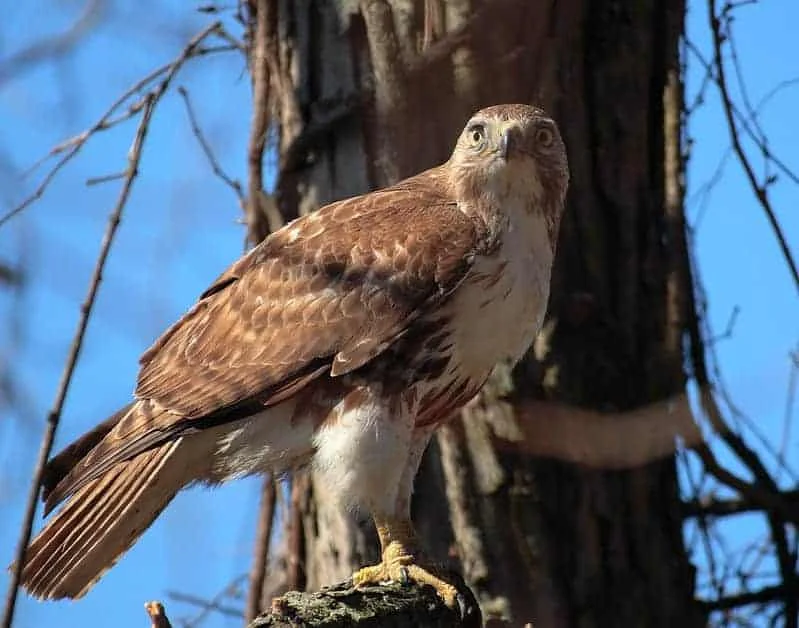
As the red-tailed hawk maintains a year-round presence all throughout the US, it should come as no surprise that they have a strong population in the Lonestar State.
This is a Canadian breeder that spreads throughout the rest of North America, and as far south as Central America. Red-tailed hawks are recognized by their distinctive red feathers on their tails, as well as their large size compared to most other hawks.
Their plumage is usually dark brown or gray speckled with lighter shades of the same color on the backside (the crown, wings, and back), with white stomachs and wing undersides.
This raptor hunts in all habitats, from mountains to forests, to open planes, preferring to spy prey from its perch and swoop down when it scampers from cover.
They are the prototypical ‘roadside raptor’ as well, often seen on the side of secluded highways watching drivers from atop road signs.
2. Northern Harrier
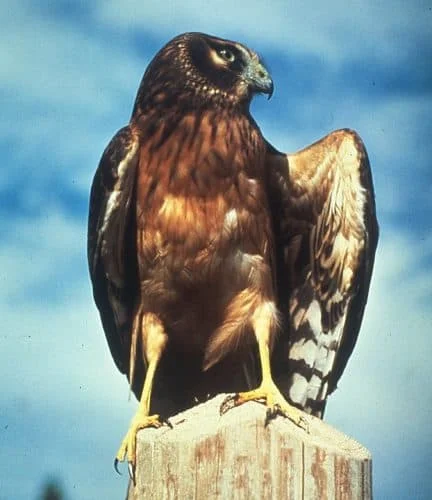
The ‘northern’ part of this hawk’s name comes from its arctic roots in Alaska and the northernmost parts of Canada.
Like many North American birds considered ‘arctic’, harriers must still fly south when food becomes scarce, and it settles throughout Texas.
These are distinct hawks, more owl-like than resembling any of their kind, with several color variations, and hunting methods that were noteworthy enough that it became its name.
The plumage on a harrier ranges from all-gray with white accents; to deep brown wings and back with an orange/light-brown belly; to mostly white albinos with gray accents across the wings, back, and crown.
The name ‘harrier’ comes from its tendency to soar above hunting grounds for extended periods of time rather than watching from a perch, which is to ‘harry’ its prey.
As a result, this hawk will frequent lowlands without nearby trees far more often than others.
3. Ferruginous Hawk
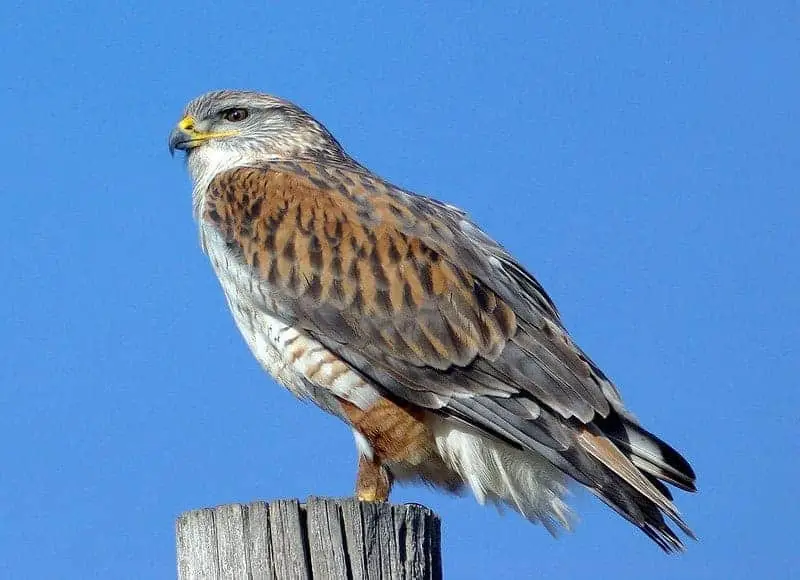
These hawks can be found all-year at the northern border of Oklahoma, and will frequently spread to central and western Texas in the winter.
The word ‘ferruginous’ figuratively means ‘rust colored’ which describes the coloring on this bird’s back, shoulders, and crown, made more prominent because the rest of its body is usually pristine white.
There are also less-common brown morphs which replace the white coloring, but still have the rust-colored patterns in the same places, though less visible. Its size is comparable to the red-tailed hawk, among the largest in North America, though dwindling numbers due to habitat destruction have rendered it a rare sight outside of the deep woods near low-lying grass or marshlands.
4. Swainson’s Hawk
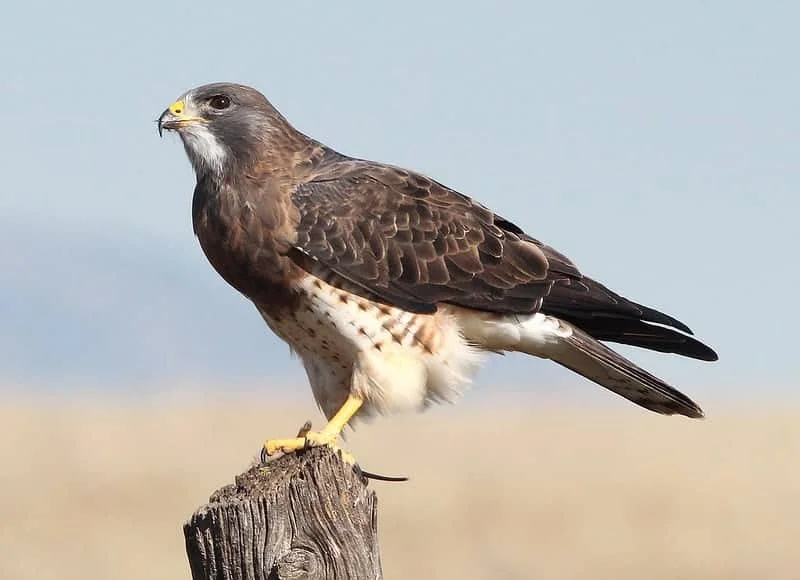
This is the rare American hawk that breeds mostly in the US instead of moving south from Canada. Swainson’s frequent the western US in areas that are considered closest to arid deserts, including large gatherings in western and central Texas.
This hawk has a regal profile, with a broad head and sharp hooked beak that resembles a small eagle. It’s coloring trends toward combinations of dark grays and browns with a light underside, that is speckled with that same color.
Adult males have a recognizable patch of brown feathers across the neck resembling a bib.
Like most hawks, this raptor likes to perch in tall trees like pines at the edge of the woods, where it can spy critters running across open plains nearby.
5. Sharp-shinned Hawk
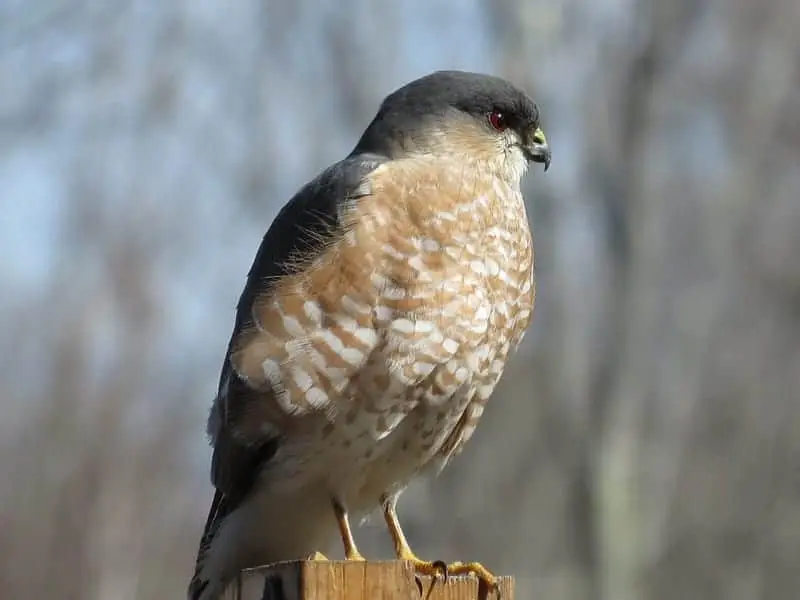
Referred to in bird watching circles as “sharpies” these are the smaller versions of coopers with similar behaviors that can make even the most expert bird specialists mistake one for the other.
They are much smaller than Cooper’s, and perhaps easier to spot as they migrate in large groups throughout Texas in the winter.
“Sharpies” are acrobatic hunters, revered among bird enthusiasts for their ability to weave between obstacles in flight and strike at prey with precision on the ground and in the air.
6. Cooper’s Hawk
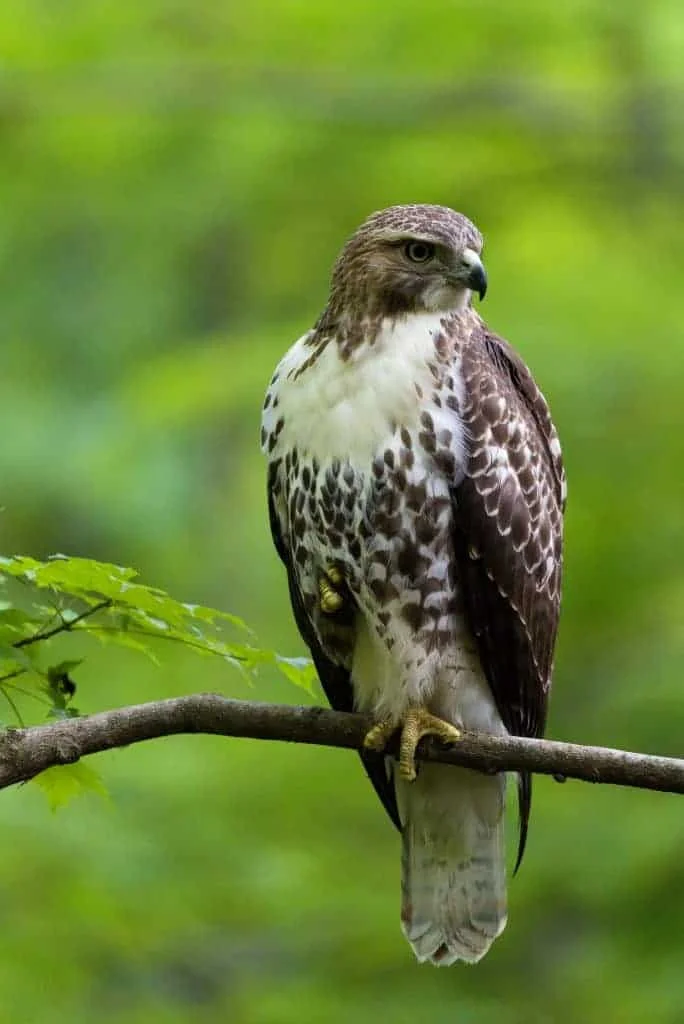
Mostly a winter visitor to Texas, the Cooper’s hawk settles in the highgrounds of central Texas during these seasons, and has a year-round presence near both the eastern and western borders.
You can recognize a Cooper’s by its contrasting rust and white colored stomach against its blue gray wings, back, and crown.
Bear in mind, you may also be looking at a sharp-shinned hawk, which has the same color patterns but is larger.
This is one of the more antisocial birds on this list avoiding the roadsides and any semblance of civilization, where it can hunt other birds in peace out in the deep woods near rivers.
7. Harris’s Hawk
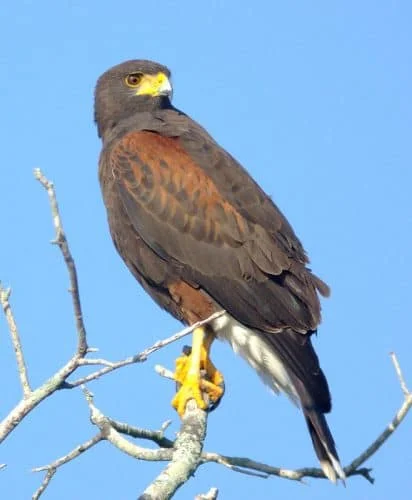
One of the rarest among the hawks that live in America, continued conservation efforts have allowed the Harris’s hawk to proliferate in southern Texas.
In fact, this desert hawk is an all-year resident near the Mexican border. Unlike most of its kind, this raptor commonly has a single-color scheme (as opposed to two-tone), which ranges from deep brown to black.
Adult males have red feathers across the ‘shoulders’ and legs, with bright, contrasting white feathers on its belly and stripes across the tail.
Harris’s hawks are known for hunting in pairs and trios–making them easier to spot–and you are more likely to find them among the sporadic trees that grow around deserts than in the lush green forests or mountains.
8. Rough-legged Hawk
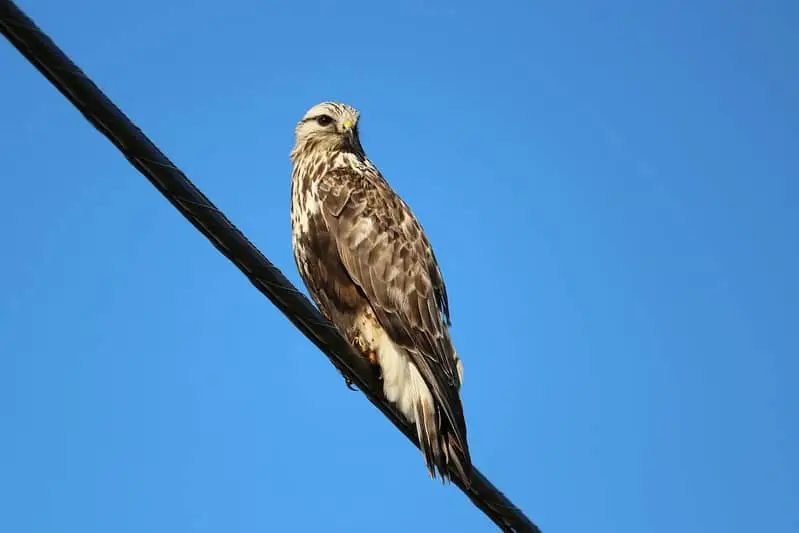
Named for the rough feathers that run from its belly to feet, the rough-legged hawk is an arctic bird that flies south to places like north Texas in the coldest times of year.
Also noteworthy are its hunting patterns, which use constant flight above low grounds to seek prey (like harriers), and strikes from a stationary perch like a treetop (like most other hawks).
Expect to see these raptors in the highlands, including mountains, where the crisp air reminds them of their homes in northern Canada. Look for plumage that appears to be a sporadic mixture of whites, light brown, and dark brown across most of its body.
Patterns are usually darker colors on the face, crown, shoulders and back, with white wingtips and belly speckled with these same colors, but it is not uncommon to see all these colors completely reversed.
9. White-tailed Hawk
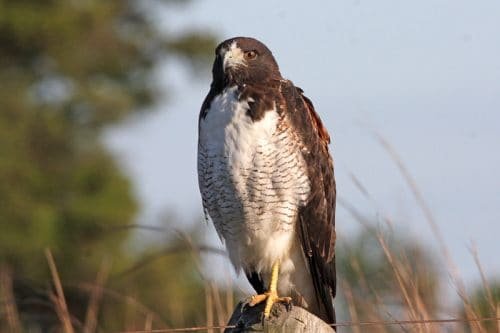
This hawk is special in those that visit the US, in that it only appears in the prairies to east Texas. White-tails mostly prefer tropical grasslands father south into Central America, but find the climate of this part of Texas to be close enough.
They are mostly a shade of light or dark gray, with light grey underbellies, and stark whitetails that grant its name. Adult males will have a prominent brown stripe running from their shoulder to half their wing.
Like most hawks, they hang out in perches and await the movement of small animals before swooping down, though these are almost always tropical grasslands near the southeast coast (as opposed to deep woods or riverbanks).
10. Zone-Tailed Hawk
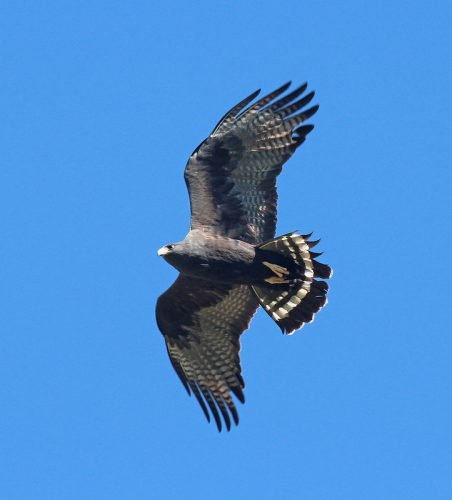
Like the white-tails, this is another uncommon southern bird, except it has a more prominent breeding presence in southwest Texas. It frequents the more arid locations near the mexican border, flying over dry lowlands like a harrier and returning to the sparse gatherings of trees found near these areas.
The name refers to the prominent white and black stripes on its tail, which break the colors into distinct ‘zones’ rather than the colors bleeding together like many birds.
Elsewhere, its coloring trends toward a single color, either a dark gray that’s almost black, or an even gray, with light feathers resembling the strips of the tail at the wingtips (though less pronounced).
11. Broad-winged Hawk
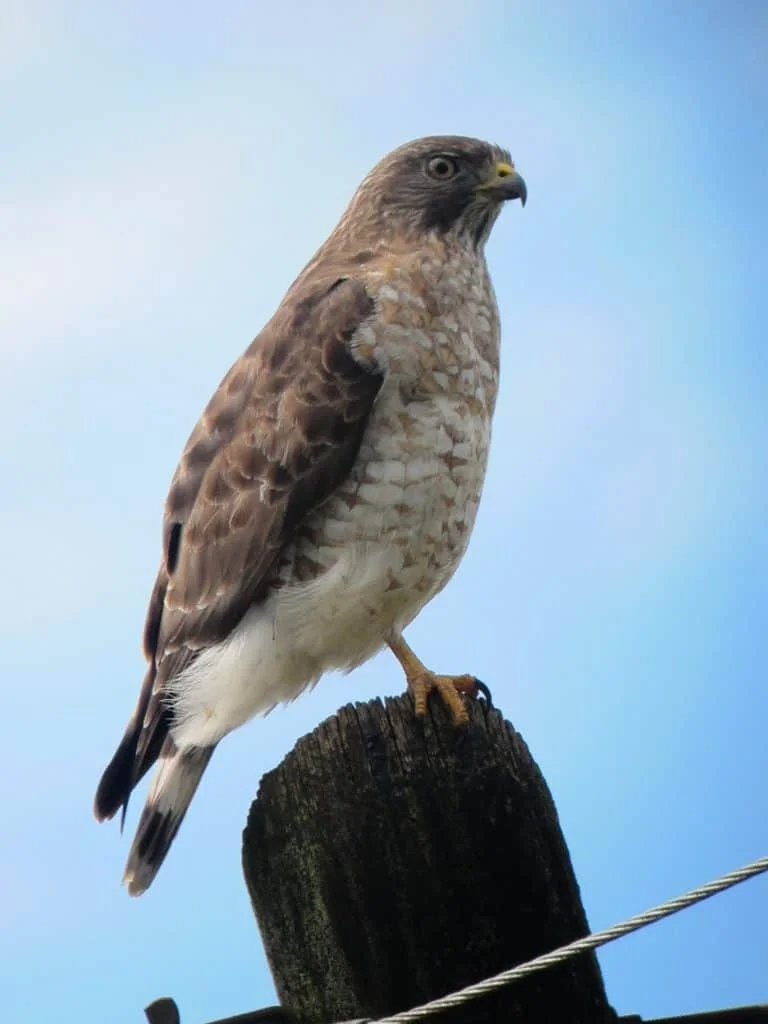
This aptly-named hawk is easier to spot when it’s flying overhead, as the size of its wings is highly visible. Equally visible is the prominent white stripe running across its dark tail.
The rest of the broad-winged hawk’s feathers are usually a blend of light and dark brown or gray, with the dark colors on the backside and the lighter colors covering the undersides.
Wings are often a starker white than their light brown-striped bellies, with the similar white-striped pattern as the tail near the wingtips. Broad-winged hawks are infrequent breeders in the easternmost part of Texas, with some uncommon migration patterns that carry them west, but not frequently enough to be noteworthy.
They wait in wooded perches like most hawks, except they are more likely to hunt near water sources and riparian zones. They are most commonly known for their large migration groups, called ‘kettles’, though this mostly occurs east of Texas.
References
- https://www.audubon.org/field-guide/bird/northern-harrier
- https://www.audubon.org/field-guide/bird/swainsons-hawk
- https://www.audubon.org/field-guide/bird/ferruginous-hawk
- https://www.audubon.org/field-guide/bird/northern-goshawk
- https://www.audubon.org/field-guide/bird/sharp-shinned-hawk
- https://www.wikipedia.org/wiki/texas
- https://www.audubon.org/field-guide/bird/white-tailed-hawk
- https://www.audubon.org/field-guide/bird/zone-tailed-hawk

About Us
We are avid bird-watchers who recently retired, allowing us more time to travel the world. Fortunately, we have managed to visit numerous countries around Europe, Asia, and America. Watching and photographing birds has been a passion for many years and we are making the most of the extra time on our hands!
